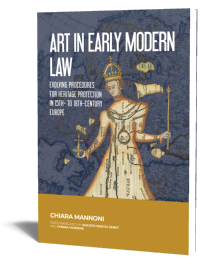Shaman and Intangible Heritage in Northern China
Critical Heritage Studies, UNESCO, and Media Archaeology
Jiyun Zhang | Forthcoming

Shaman and Intangible Heritage in Northern China
Critical Heritage Studies, UNESCO, and Media Archaeology
Jiyun Zhang | Forthcoming
Paperback ISBN: 9789464281057 | Hardback ISBN: 9789464281064 | Imprint: Sidestone Press Dissertations | Format: 182x257mm | ca. 234 pp. | Language: English | 6 illus. (bw) | 40 illus. (fc) | Keywords: intangible cultural heritage; shamanism; media archaeology; critical heritage studies; UNESCO; actor-network theory; indigenous ontologies; digital heritage; cultural resilience; sustainability; China; animism | download cover | DOI: 10.59641/aa545dm | CC-license: CC BY 4.0
Publication date: 05-11-2025
-
Digital & Online access
Digital/Online version not (yet) available
-
Buy via Sidestone (EU & UK)
Get €5.00 discount on forthcoming books by using coupon code "PRE-ORDER" in your shopping cart!
-
Buy via our Distributors (WORLD)
For non-EU or UK destinations you can buy our books via our international distributors. Although prices may vary this will ensure speedy delivery and reduction in shipping costs or import tax. But you can also order with us directly via the module above.
For UK & other International destinations
For USA/Canada & other International destinations
-
Bookinfo
Paperback ISBN: 9789464281057 | Hardback ISBN: 9789464281064 | Imprint: Sidestone Press Dissertations | Format: 182x257mm | ca. 234 pp. | Language: English | 6 illus. (bw) | 40 illus. (fc) | Keywords: intangible cultural heritage; shamanism; media archaeology; critical heritage studies; UNESCO; actor-network theory; indigenous ontologies; digital heritage; cultural resilience; sustainability; China; animism | download cover | DOI: 10.59641/aa545dm | CC-license: CC BY 4.0
Publication date: 05-11-2025

We will plant a tree for each order containing a paperback or hardback book via OneTreePlanted.org.
The 21st-century media landscape is transforming how cultural heritage is perceived, practiced, and sustained. While media technologies accelerate global exchanges, tensions persist, if not deepen—between the obsolete and the innovative, local traditions and global narratives, and the past and an uncertain future. These challenges complicate efforts to sustain cultural heritage in inclusive, resilient, and ecologically attuned ways.
This book examines how media technologies, environmental shifts, and transcultural exchanges are reshaping intangible cultural heritage (ICH) in contemporary China. Integrating historical, cultural, and technological perspectives, it challenges colonial and modernist biases that have marginalized shamanistic practices and critiques conventional notions of authenticity.
Drawing on Actor-Network Theory, Entanglement Theory, Panpsychism, and Indigenous ontologies, it offers a fresh perspective on the interplay between human and non-human actors in heritage-making, repositioning “animism” and “shamanism” as interconnected systems that foster ecological stewardship, cultural resilience, and sustainable governance. It also interrogates UNESCO’s heritage frameworks, highlighting both their potential and limitations in safeguarding shamanistic expressions.
Through an interdisciplinary lens blending material-oriented media archaeology with socially conscious critical heritage studies, it interrogates how digital technologies—from animation and immersive storytelling to ICH nomination videos—mediate heritage and shape perceptions. It reveals how media acts as a cultural broker and a disruptive force, reinforcing or challenging marginalization and dominant narratives while fostering participatory, reflexive heritage-making. This approach reintroduces human agency into discussions of technology and sustainability, framing ICH safeguarding as a global niche construction project integral to achieving resilient and sustainable futures.
By bridging cultural tradition and media innovation, it provides a timely roadmap for researchers, policymakers, and heritage and media practitioners navigating the complexities of heritage safeguarding, digital transformation, and sustainability. It advocates for participatory and interdisciplinary approaches that value local knowledge and nuance, cultural diversity, and adaptive strategies in an era of rapid socio-technological transformation.
List of Abbreviations
Acknowledgment
Introduction
Subjects and Concepts
Objectives, the Scope of Investigation, and Methodology
Data Collection
Structure
PART 1 SHAMANISTIC PAST AND “MODERN” CHINA
Chapter 1 From Time Traveling Shows to a Shamanistic History
1. A Step into the Past
2. The Historian’s Identity: From 巫 (wū, shaman) to History
3. “Shaman,” “Shamanism,” and “Shamanistic”
Chapter 2 The Crisis of Time and Diffusion of Shamanistic Expressions
1. Crisis of Time, Heritage, and “Modernity”
2. From “Cultural Property” to “World Heritage”
3. Diffusion and Transformation of 巫 (wū): “Folk Tradition” and “Superstition” in China
4. Oppression, Resilience, and Continuity of Shamanistic Expressions
PART 2. SHAMAN, INTANGIBLE HERITAGE, AND SUSTAINABLE DEVELOPMENT
Chapter 3 Heritage, UNESCO, and Sustainability: Local/Indigenous Communities and Shamanistic Expressions
1. A “Modern” Understanding and Management of “Nature”
2. The World Heritage Convention and Indigenous/Local Communities
3. Significances of Shamanistic Expressions as Heritage
4. “Shamanism,” UNESCO, and the Semantic Expansion of Cultural Heritage
Chapter 4 The Reclaiming Native Truth Project and the 2003 Convention in Action
1. Address Invisibility, Fossilization, and Reduction of Indigenous Culture
2. Safeguarding ICH as a Means to Strengthen the Indigenous CGIs
3. Legal, Educational, and Economic Challenges and Potentials
4. Participation, Capacity and Cultural Competency
Chapter 5 Reassessment of Animism: Agencies of Plants, Animals, and Objects
1. Animism and 万物有灵 (wàn wù yǒu línɡ): A “Modern” Interpretation and a Chinese Translation
2. Mediating Agency in Plants
3. Rethinking Intelligence, Emotions, and Ethics Across Lifeforms
4. Objects and Technology as Mediator
5. Cultural, Ethical, and Environmental Implications of Relational Thinking
Chapter 6 Disaster, Crisis, and Sustainability: Confucian Cosmology as Intangible Heritage
1. Disaster and Crisis: Is There Such a Thing as a Natural Disaster?
2. Confucian Disaster Discourse and Sustainability
3. The Safeguarding of ICH and Cultural Niche Construction
PART 3. SHAMANISTIC EXPRESSIONS AS INTANGIBLE HERITAGE AMONG GROUPS IN NORTHERN CHINA
Chapter 7 The Formation and Transformation of Shamanistic Expressions and Collective Identities in Northern China
1. Environmental History, ICH, and “Ethnicity”
2. The Transformation of Northern Groups During the Qing Dynasty
3. Transformations of Manchu Ritual Practices in the Qing Dynasty
4. The Tension Between “Nation” and “Ethnicity”
Chapter 8 Shamanistic Expressions of Northern China in Museums and Tourist Sites
1. Public Museums and “Modernity”
2. Transculturation and Cultural Translation
3. “Shamanistic Totem Poles” and “Authenticity”
4. Labeling and Interpretation
5. The Notice and Museum Performance
PART 4. MEDIA AND HERITAGE-MAKING
Chapter 9 From Lanterns to Digital Landscapes: The Interplay of Media Technology, Society, and Intangible Cultural Heritage
1. Shaman and Media
2. Healing with Puppetry Animation
3. Mediating Through Animation and Cinema
4. Media Archaeology and Cinema
5. From Nineteenth Century “Optical Toys” to Safeguarding ICH
Chapter 10 Reframed and Augmented: Intangible Cultural Heritage in Nomination Videos
1. Media’s Role in ICH Safeguarding
2. Operational Guidance, Challenges, and Notable Practices of Nomination Videos
3. Nomination Videos from China: Vehicles for Past, Present, and Future Narratives
4. Expository Strategies in Nomination Videos
Chapter 11 The Crisis in Representing “Authenticity” and the Expansion of Audiovisual Presentation
1. The Construction and Reconstruction of Collective Memories
2. The Cultural Heritage of Wang Zhaojun
3. Performing “Authenticity” in Mockumentary
4. Inherent Inauthenticity
5. Expansion of Audiovisual Interpretation and Representation
CONCLUSIONS
BIBLIOGRAPHY

Dr. Jiyun Zhang
Jiyun (June) Zhang is an independent animation film practitioner and a scholar in the ARCHES research group at the Faculty of Design Sciences, University of Antwerp. She specializes in cultural heritage, media archaeology, and audiovisual storytelling. She holds a Doctorate in Cultural Heritage Studies from Vrije Universiteit Brussel (VUB) and has an academic and artistic background in journalism and animation film, with degrees in audiovisual arts from KASK & Conservatorium: School of Arts Gent.
Abstract:
The 21st-century media landscape is transforming how cultural heritage is perceived, practiced, and sustained. While media technologies accelerate global exchanges, tensions persist, if not deepen—between the obsolete and the innovative, local traditions and global narratives, and the past and an uncertain future. These challenges complicate efforts to sustain cultural heritage in inclusive, resilient, and ecologically attuned ways.
This book examines how media technologies, environmental shifts, and transcultural exchanges are reshaping intangible cultural heritage (ICH) in contemporary China. Integrating historical, cultural, and technological perspectives, it challenges colonial and modernist biases that have marginalized shamanistic practices and critiques conventional notions of authenticity.
Drawing on Actor-Network Theory, Entanglement Theory, Panpsychism, and Indigenous ontologies, it offers a fresh perspective on the interplay between human and non-human actors in heritage-making, repositioning “animism” and “shamanism” as interconnected systems that foster ecological stewardship, cultural resilience, and sustainable governance. It also interrogates UNESCO’s heritage frameworks, highlighting both their potential and limitations in safeguarding shamanistic expressions.
Through an interdisciplinary lens blending material-oriented media archaeology with socially conscious critical heritage studies, it interrogates how digital technologies—from animation and immersive storytelling to ICH nomination videos—mediate heritage and shape perceptions. It reveals how media acts as a cultural broker and a disruptive force, reinforcing or challenging marginalization and dominant narratives while fostering participatory, reflexive heritage-making. This approach reintroduces human agency into discussions of technology and sustainability, framing ICH safeguarding as a global niche construction project integral to achieving resilient and sustainable futures.
By bridging cultural tradition and media innovation, it provides a timely roadmap for researchers, policymakers, and heritage and media practitioners navigating the complexities of heritage safeguarding, digital transformation, and sustainability. It advocates for participatory and interdisciplinary approaches that value local knowledge and nuance, cultural diversity, and adaptive strategies in an era of rapid socio-technological transformation.
Contents
List of Abbreviations
Acknowledgment
Introduction
Subjects and Concepts
Objectives, the Scope of Investigation, and Methodology
Data Collection
Structure
PART 1 SHAMANISTIC PAST AND “MODERN” CHINA
Chapter 1 From Time Traveling Shows to a Shamanistic History
1. A Step into the Past
2. The Historian’s Identity: From 巫 (wū, shaman) to History
3. “Shaman,” “Shamanism,” and “Shamanistic”
Chapter 2 The Crisis of Time and Diffusion of Shamanistic Expressions
1. Crisis of Time, Heritage, and “Modernity”
2. From “Cultural Property” to “World Heritage”
3. Diffusion and Transformation of 巫 (wū): “Folk Tradition” and “Superstition” in China
4. Oppression, Resilience, and Continuity of Shamanistic Expressions
PART 2. SHAMAN, INTANGIBLE HERITAGE, AND SUSTAINABLE DEVELOPMENT
Chapter 3 Heritage, UNESCO, and Sustainability: Local/Indigenous Communities and Shamanistic Expressions
1. A “Modern” Understanding and Management of “Nature”
2. The World Heritage Convention and Indigenous/Local Communities
3. Significances of Shamanistic Expressions as Heritage
4. “Shamanism,” UNESCO, and the Semantic Expansion of Cultural Heritage
Chapter 4 The Reclaiming Native Truth Project and the 2003 Convention in Action
1. Address Invisibility, Fossilization, and Reduction of Indigenous Culture
2. Safeguarding ICH as a Means to Strengthen the Indigenous CGIs
3. Legal, Educational, and Economic Challenges and Potentials
4. Participation, Capacity and Cultural Competency
Chapter 5 Reassessment of Animism: Agencies of Plants, Animals, and Objects
1. Animism and 万物有灵 (wàn wù yǒu línɡ): A “Modern” Interpretation and a Chinese Translation
2. Mediating Agency in Plants
3. Rethinking Intelligence, Emotions, and Ethics Across Lifeforms
4. Objects and Technology as Mediator
5. Cultural, Ethical, and Environmental Implications of Relational Thinking
Chapter 6 Disaster, Crisis, and Sustainability: Confucian Cosmology as Intangible Heritage
1. Disaster and Crisis: Is There Such a Thing as a Natural Disaster?
2. Confucian Disaster Discourse and Sustainability
3. The Safeguarding of ICH and Cultural Niche Construction
PART 3. SHAMANISTIC EXPRESSIONS AS INTANGIBLE HERITAGE AMONG GROUPS IN NORTHERN CHINA
Chapter 7 The Formation and Transformation of Shamanistic Expressions and Collective Identities in Northern China
1. Environmental History, ICH, and “Ethnicity”
2. The Transformation of Northern Groups During the Qing Dynasty
3. Transformations of Manchu Ritual Practices in the Qing Dynasty
4. The Tension Between “Nation” and “Ethnicity”
Chapter 8 Shamanistic Expressions of Northern China in Museums and Tourist Sites
1. Public Museums and “Modernity”
2. Transculturation and Cultural Translation
3. “Shamanistic Totem Poles” and “Authenticity”
4. Labeling and Interpretation
5. The Notice and Museum Performance
PART 4. MEDIA AND HERITAGE-MAKING
Chapter 9 From Lanterns to Digital Landscapes: The Interplay of Media Technology, Society, and Intangible Cultural Heritage
1. Shaman and Media
2. Healing with Puppetry Animation
3. Mediating Through Animation and Cinema
4. Media Archaeology and Cinema
5. From Nineteenth Century “Optical Toys” to Safeguarding ICH
Chapter 10 Reframed and Augmented: Intangible Cultural Heritage in Nomination Videos
1. Media’s Role in ICH Safeguarding
2. Operational Guidance, Challenges, and Notable Practices of Nomination Videos
3. Nomination Videos from China: Vehicles for Past, Present, and Future Narratives
4. Expository Strategies in Nomination Videos
Chapter 11 The Crisis in Representing “Authenticity” and the Expansion of Audiovisual Presentation
1. The Construction and Reconstruction of Collective Memories
2. The Cultural Heritage of Wang Zhaojun
3. Performing “Authenticity” in Mockumentary
4. Inherent Inauthenticity
5. Expansion of Audiovisual Interpretation and Representation
CONCLUSIONS
BIBLIOGRAPHY

Dr. Jiyun Zhang
Jiyun (June) Zhang is an independent animation film practitioner and a scholar in the ARCHES research group at the Faculty of Design Sciences, University of Antwerp. She specializes in cultural heritage, media archaeology, and audiovisual storytelling. She holds a Doctorate in Cultural Heritage Studies from Vrije Universiteit Brussel (VUB) and has an academic and artistic background in journalism and animation film, with degrees in audiovisual arts from KASK & Conservatorium: School of Arts Gent.
-
Digital & Online access
Digital/Online version not (yet) available
-
Buy via Sidestone (EU & UK)
Get €5.00 discount on forthcoming books by using coupon code "PRE-ORDER" in your shopping cart!
-
Buy via our Distributors (WORLD)
For non-EU or UK destinations you can buy our books via our international distributors. Although prices may vary this will ensure speedy delivery and reduction in shipping costs or import tax. But you can also order with us directly via the module above.
For UK & other International destinations
For USA/Canada & other International destinations
- Browse all books by subject
-
Search all books

We will plant a tree for each order containing a paperback or hardback book via OneTreePlanted.org.
You might also like:
© 2025 Sidestone Press KvK nr. 28114891 Privacy policy Sidestone Newsletter Terms and Conditions (Dutch)








